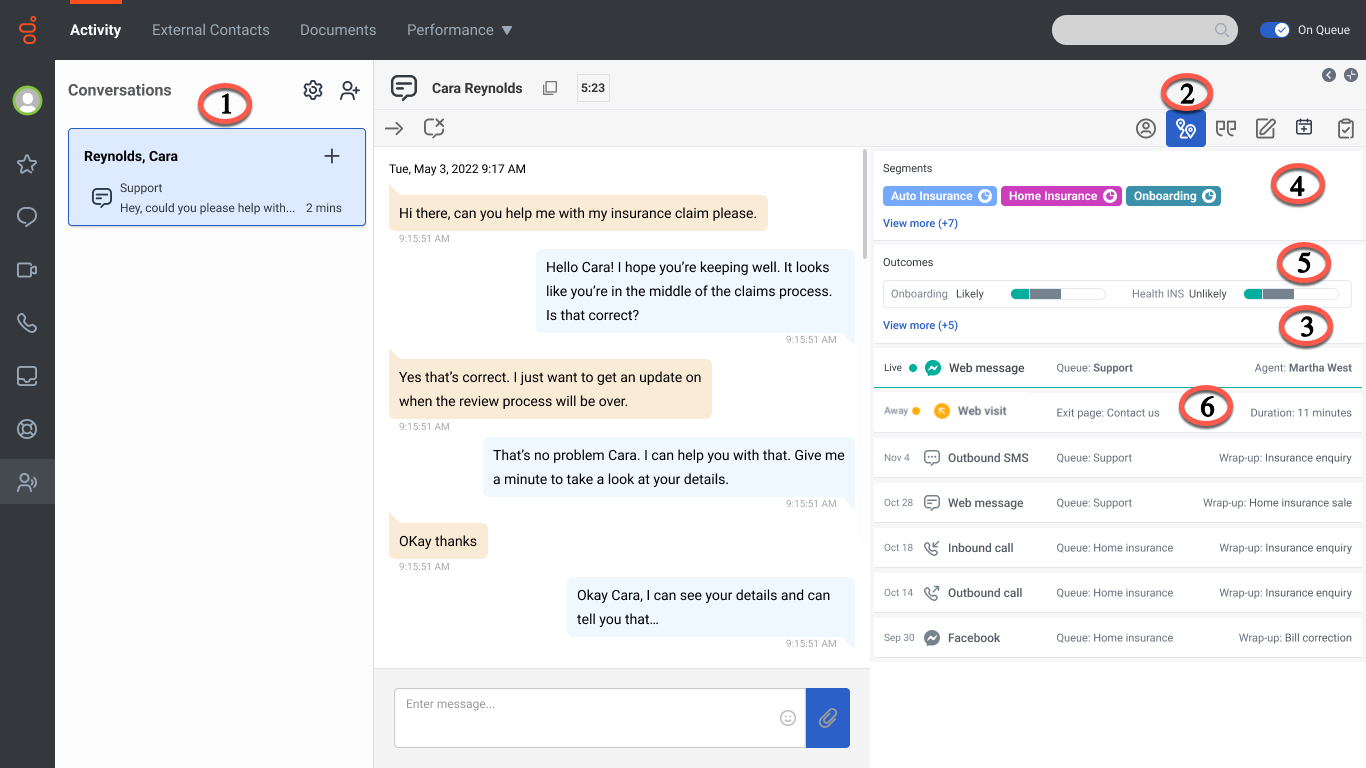View a Predictive Engagement customer’s journey
Prerequisites
The following permissions:
- Journey > Event > View (core permission to view the Customer journey gadget and to see detailed view web sessions)
- Journey > Event Type > View (to allow customization of web sessions)
- Journey > Session > View (to retrieve list of web session, assign the necessary divisions to the user role to view the division-specific conversation data)
- Journey > Session Type > View (to retrieve details of web sessions)
- Journey > Outcome > View (to see outcomes achieved and scores for a visit)
- Journey > OutcomeScores > View (to see real-time predictions)
- Journey > Segment > View (to see matched segments for a visit)
- External contacts > Session > View (to enable view of customer journey tab, assign the necessary divisions to the user role to view the division-specific journey data)
- Routing > Wrap up code > View (to view the wrap-up codes associated with the interaction)
- Routing > Queue > Search (to view the queue the interaction is part of)
If a visitor accepts a web chat or web messaging offer from Genesys Predictive Engagement, customer journey information displays in the Interactions panel. Use the customer journey page to view an overall summary of the different interactions you have had with the customer and the journeys of a customer on the website that Genesys Predictive Engagement tracks.
Viewing the customer’s various touchpoints with your business helps you understand the customer’s needs better. When an agent views the customer journey and the associated information such as notes or wrap-codes of previous interaction.
Customer journey information is available for conversations from the following channels:
- Voice
- Inbound calls
- Agent-initiated outbound calls
- Messaging
- Web Messaging
- Web chat
- Digital
- SMS
- Agentless notifications (WhatsApp and SMS)
- Social media
- LINE
- Twitter SM
- Facebook messenger
- Website visits
- Web Events
- Content Offers
Customer journey information is not available for conversations from the following channels:
- Knowledge – Support center
- Agentless email notifications (Email and SMS)
- Campaigns, including callbacks
- Co-browse
- Instagram DM

- Conversations panel: Displays your current interactions, such as inbound calls, outbound calls, and message interactions.
- Customer Journey icon: Opens the Customer Journey tab, which displays a customer’s contextual journey history.
- Interactions: List of the customer’s current and historical interactions. To view an interaction’s agent and queue details, click the interaction. The journey card displays the information at the bottom. The journey card displays the details of the last queue and agent when an interaction is transferred between different queues and agents. For more information, see View current and historical activity in interaction journey cards.
For active web messaging interactions, “Live” appears in the first column with a green status icon. After 45 seconds of inactivity, the icon changes to yellow. After 1 minute of inactivity, the interaction shows as inactive. It remains inactive unless the customer triggers another web event (for example, a page view), at which point the interaction shows as “live” again.
For active inbound and outbound call interactions, “Live” appears in the first column with a green status icon. When you wrap up the call, the interaction shows as inactive. The activities of the previous 60 days are available.
For past interactions, the date the interaction occurred appears in the first column. - Outcomes: Outcomes that your organization wants to achieve and the customer’s progress toward those outcomes appear in this section. For example, if the desired outcome is for the visitor to purchase a product, the visitor’s progress moves toward that goal when the visitor puts an item in their shopping cart. These bars update in real time as the visitor’s progress changes.
- Segments: Segments that the customer matched appear in this section. A segment represents a group of visitors who share similar behavior or characteristics. For example, a segment might include all customers who use the same browser or are from the same geographic region. Segments appear in the order that Genesys Predictive Engagement assigns them to the visitor.
- Web visits: Interactions include web visits. Single customer view offers the ability to track web visits across different mobile, desktop, and tablet browsers which enables the web visits on these various devices to be stitched by a web ID/cookie identifier. For example, if a customer provides their email address on a desktop and then interacts on a web message by providing their email address from their tablet, these two web visits are available under one profile.
For active web visits, “Live” appears in the first column with a green status icon. After 45 seconds of inactivity, the icon changes to yellow. After 1 minute of inactivity, the interaction shows as inactive. It remains inactive unless the customer triggers another web event (for example, a page view), at which point the interaction shows as “live” again.

